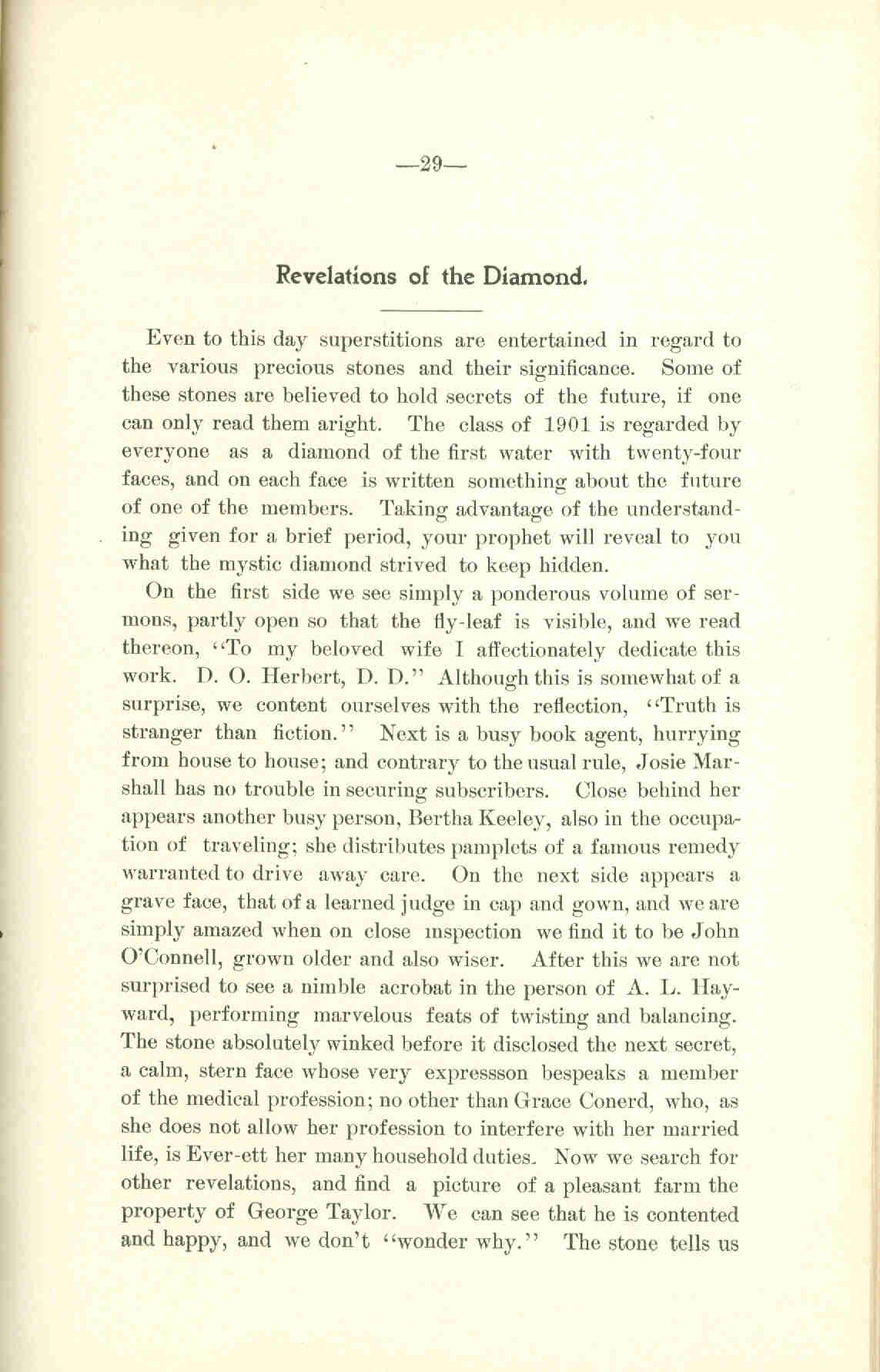--29--
Even to this day superstitions are entertained in regard to the various precious stones and their significance. Some of these stones are believed to hold secrets of the future, if one can only read them aright. The class of 1901 is regarded by everyone as a diamond of the first water with twenty-four faces, and on each face is written something about the future of one of the members. Taking advantage of the understanding given for a brief period, your prophet will reveal to you what the mystic diamond strived to keep hidden.Revelations of the Diamond.
On the first side we see simply a ponderous volume of sermons, partly open so that the fly-leaf is visible, and we read thereon, "To my beloved wife I affectionately dedicate this work. D. O. Herbert, D. D." Although this is somewhat of a surprise, we content ourselves with the reflection. "Truth is stranger than fiction." Next is a busy book agent, hurrying from house to house; and contrary to the usual rule, Josie Marshall has no trouble in securing subscribers. Close behind her appears another busy person, Bertha Keeley, also in the occupation of traveling; she distributes pamplets of a famous remedy warranted to drive away care. On the next side appears a grave face, that of a learned judge in cap and gown, and we are simply amazed when on close inspection we find it to be John O'Connell, grown older and also wiser. After this we are not surprised to see a nimble acrobat in the person of A. L. Hayward, performing marvelous feats of twisting and balancing. The stone absolutely winked before it disclosed the next secret, a calm, stern face whose very expression bespeaks a member of the medical profession; no other than Grace Conerd, who, as she does not allow her profession to interfere with her married life, is Ever-ett her many household duties. Now we search for other revelations, and find a picture of a pleasant farm the property of George Taylor. We can see that he is contented and happy, and we don't "wonder-why." The stone tells us
--30--
that one of the girls has taken to the stage, Nellie Franklin, who is a petite comedienne of no mean ability. Next it shows us another home, as quiet and neat as the most fastidious person could wish. We hardly need to be told that Mabel Woodward has this home in charge, and that everything she attempts is done quite Brown. After this we come across some queer looking machinery, bearing this label, "Climbing Apparatus; Steinke & Low, Lt'd." The class can boast of an eminent novelist, and also an artist, in the persons of Belle Colver and Arletta Vail. Dealers complain of their inability to meet the public demand for the production of these two members. Of all persons in the class one would least expect to find Mabel Hartshorn a lecturer, yet such she is, and her fluency is the wonder and admiration of all who have the pleasure of hearing her. That the education of Young America is an important duty has been fully appreciated by Belle Bradbury, a learned college instructor. Our class president, W. H. Scheel, has developed into a re-li-able historian, and his works are regarded by the severest critics as being strictly authentic. Photography with all its marvels and possibilities has been investigated to a great extent by Claude Camblin who is a wide-awake "picture grafter" in a western town. The next revelation is a sign, "Charles Hulley, Groceries and Provisions." Live and let live, is his motto, and all of his cutomers unite in saying that he is a good fellow and "Hully" reliable. Mary Kringel is an up-to-date dentist, and can load one's mouth with store molars that can not be detected from the real article. "Aching offenders extracted while you wait," she obligingly advertises. We do not start with surprise to learn that Clara Coe is sewing for a Taylor, or that Beulah Kringel is an efficient superintendent of schools in an Iowa town. From the dimly visible portion of a newspaper we learn that Brother H. Shover Cary sailed yesterday on a steamer bound for Foochow, China, in which country he intends to work as a missionary. Next comes Beatrice Reynolds, a brilliant musician and composer, conceded to be the greatest of modern times, and second to no ancient master. She soars with ease to the high C's; in fact many young gentlemen have been heard to remark that she is
--31--
"'way up in G." And now the future of but one more remains to be told. At first this seemed to be a flawless stone, but this last side is remarkably dim and shows only the shadowy outlines of something closely resembling an interrogation point. The future of the class, according to the faces of the diamond, has been told. Whether all will perform the tasks alloted to them remains for time to disclose. FANNIE SANFORD.
Copyright © 1996
The IAGenWeb Project
IAGenWeb Terms, Conditions
& Disclaimer




